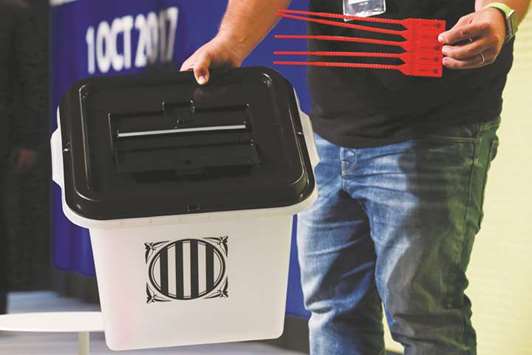Here are the key dates in the Spanish region’s independence drive.
n March 30, 2006: Spain’s parliament approves a new autonomy charter for Catalonia that increases the region’s fiscal and judicial powers and describes it as a “nation”.
n July 31, 2006: Prime Minister Mariano Rajoy’s conservative Popular Party (PP), which has only marginal support in Catalonia, appeals against the autonomy charter, accusing it of “privileging” Catalonia.
n June 28, 2010: The Constitutional Court strikes down parts of the 2006 charter. It rules that using the word “nation” to describe the region has “no legal value” and rejects the “preferential” use of the Catalan language in municipal services.
n July 10, 2010: Hundreds of thousands of people protest in Barcelona, the capital of Catalonia, chanting “We are a nation, we decide”.
n September 11, 2012: At the height of Spain’s economic crisis, more than 1mn people protest in Barcelona on Catalonia’s national day, demanding independence in what turns into an annual tradition.
n September 20, 2012: Rajoy rejects Catalan President Artur Mas’s call for greater tax-and-spend powers for the region. Five days later, Mas calls a snap election promising to hold a referendum on Catalonia’s future.
n November 26, 2012: Mas’s centre-right CiU alliance wins the snap election overall but fails to secure an absolute majority in the regional parliament.
n September 11, 2013: Hundreds of thousands of Catalans join hands to form a human chain stretching more than 400km (250 miles) along the Mediterranean coast to push for independence.
n November 9, 2014: Catalonia defies Madrid and presses ahead with a symbolic vote on independence. More than 80% – 1.8mn people – vote in favour of independence but turnout is 37%.
n September 27, 2015: The pro-independence Together For Yes alliance secures 62 seats in the regional assembly and the radical leftwing separatist group CUP wins 10, giving them an absolute majority.
But the separatist bloc falls short of winning a majority in the election, which is portrayed as a proxy vote on independence, capturing just 47.8% of the ballot.
n November 9, 2015: All 72 pro-independence lawmakers in the Catalan parliament vote for a resolution that kicks off the process to secede from Spain. The resolution is later struck down by the Constitutional Court.
n January 10, 2016: Carles Puigdemont becomes Catalonia president.
n June 9, 2017: Puigdemont announces a referendum on independence to be held on October 1, which will ask voters: “Do you want Catalonia to be an independent country in the form of a republic?” Spain’s central government says it will block the referendum.
n July 3, 2017: Puigdemont dismisses a member of his regional government who raised doubts about the viability of the referendum. Three other members of his government whose support for the vote was in doubt also step down, as does the head of the regional Catalan police.
n September 6, 2017: Catalonia’s regional parliament approves a law allowing the referendum and the regional government signs a decree officially calling the vote.
n September 7, 2017: The Constitutional Court temporarily suspends the referendum following a legal challenge from Madrid but the Catalan government vows to push ahead.
n September 13, 2017: Spanish prosecutors order police to stop the referendum by seizing ballots, ballot boxes, campaign posters and other material needed to stage the vote.
n September 20, 2017: Police arrest 14 Catalan government officials suspected of organising the referendum and announce they have seized nearly 10mn ballots destined for the vote.
Thousands protest against the police crackdown in Barcelona.
n September 21, 2017: Catalan Vice-President Oriol Junqueras admits that plans to hold the referendum have been dealt a blow by the police crackdown.
n September 29, 2017: The Catalan government says it has 2,315 polling stations ready for the referendum.
n September 30, 2017: Police say they have sealed off over half of the polling stations.

The ballot box and zip-tie seals that were unveiled on Friday for the banned independence referendum.
